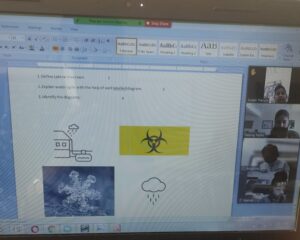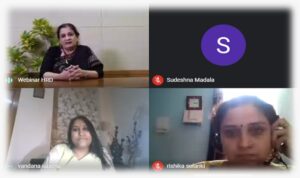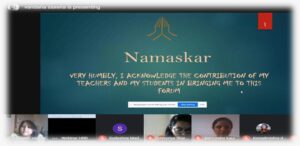Technology in education for me before COVID-19 was about recommending YouTube videos to students or creating worksheets. I would Google to get info and do research. But when the pandemic came and schools closed, I assumed there would be no learning until we returned to normal. As for the education sector, it was not ready to cope with such a scenario. But technology turned out to be a lifesaver.
In those times, blended learning became a game-changer. Services such as Google Meet, Zoom, and Microsoft Teams allowed us as teachers and students as well to continue their education. Although it was a sad phase, however I was excited for exploring exciting new means of learning and instruction such as Zoom, Liveworksheets, Kahoot, and many others. Education became digital via technology and opened up opportunities for it to be conducted in a more flexible and deliberate way. During my classes, I found my students were as engages as I used to be. They also found new platforms worthwhile. Here is a glimpse of my classroom.
However, it came with its own challenges. Especially in rural areas, not all of them had the technology they needed, such as smartphones, laptops, or at least a good internet connection. Many students in my classes could not take classes at all and it was a huge loss at their part. I used to connect with them later on via phone calls and sent them homework on WhatsApp. In India, for example, technical problems were frequent due to poor connectivity. Some of the teachers who were not tech-savvy struggled with switching their lessons to the internet. Moreover, purchasing tech tools was a financial strain on many households. Also, as mentioned in a topic of the book Teaching in a Digital Age, adding new technology to the classroom design may just increase costs, both in terms of technology and the time of instructors, without changing outcomes.
In my opinion, the greatest burden was on Kindergarten, 1st, and 2nd-grade teachers. Young children are not even able to sit in front of a computer/mobile phone and study, which must have been a big challenge for the educators. In preparing this blog, I found a video that endearingly demonstrates just some of the difficulties teachers had. I really laughed at it thinking about what challenges we as teachers went through with smiles, and I highly recommend watching it.
Although, the opportunities were priceless. I interacted with professionals from across the globe through the workshops that helped me become more confidence.


Online learning platforms also provided us free access to educational resources during these trying times, which was a big boon! In general, technology and blended learning have created new opportunities to learn, build skills, and connect with people anywhere around the world.

Hello Neeraj
Truly, the COVID-19 pandemic was a game-changer for the global education sector. This brought about the use of technology and several learning approaches. I agree with you that blended learning has brought about flexibility in how we teach, especially at the K-12 level, and the incorporation of various online activities through Kahoot games, YouTube, and other live worksheet platforms in the classroom has really transformed students’ learning. I also like the fact that you acknowledged the challenges that come with blended learning, especially for students in rural areas and families that are economically disadvantaged.
Even though challenges in using blended learning still abound, I believe that there have been changes in how this approach was utilized during the COVID period as compared to its narrative in today’s changing environment with more advanced and sophisticated technologies.
Hey Neeraj,
I completely agree with you that after COVID-19, our education system underwent a massive shift, and truly became a game changer in adapting to the situation. Those initial days were really challenging for both teachers and learners, especially in managing studies. However, technology turned out to be a real lifesaver during that time.
I also believe that technology has opened up opportunities to conduct education in a more flexible and deliberate manner. That said, I can relate to the challenges you mentioned. Back in my country, India, many families didn’t have access to smartphones, laptops, or reliable internet, which made things incredibly difficult. Personally, I’m not very tech-savvy, so I also struggled a lot with these .I really enjoyed the video you uploaded to your blog—it was very engaging. The pictures you shared of your online classes were also a great touch and much appreciated.
Thanks
Neeraj, thank you for offering your personal experience and perspective on how blended learning was adopted during the COVID-19 pandemic.
It is encouraging to see that you have positive anticipation towards the many emerging digital tools and platforms for instruction, and it is equally heartening to hear that your students were enthusiastic about these new ways of learning.
You have delineated the digital disparity and imbalances in accessing remote schooling of students, particularly the ones from rural areas, which is an important issue that needs further in-depth consideration. The inequalities created by the abrupt transition to virtual and technology-embedded learning paint a grim picture that ought to be taken very seriously. The benefits of blended learning can only be enjoyed when all learners are availed of the necessary tools and assistance.
The challenges faced by early childhood educators that you highlighted are insightful. Kids are not easy to engage in front of a screen, and your remark about the teachers bearing the brunt of the weight in this scenario is indeed an appropriate comment on the issue that needs special consideration.
The point you raised concerning investing more cost and time in blended learning not guaranteeing better learning outcomes is succinct. As we push further into blended learning, it is important to assess what impacts the expenditure has on the quality of the teaching delivered.
I appreciate how you have shown that blended learning systems can be integrated into the existing schooling system with many benefits and balanced it by drawing attention to genuine barriers and challenges towards its adoption and implementation. Such balanced views enrich the discourse about the future of education in this digital era.
Hi Neeraj!
Truly, Covid-19 affected all of us and we changed the way we taught. But I think it also brought out a change in the way education seem to be viewed and for children, the ways in which they learn. I totally agree that children who were young and their teachers faced a lot of difficulties. I really enjoyed the video that you added and feel for the teacher who is depicted there. I do realise the connectivity issues in India. We had similar ones in Oman, the country whre I taught before this and to an extent, in Canada too. But adapting to each environment proved successful for all those who persevered.
Hi Neeraj,
Your reflections on blended learning highlight both the struggles and opportunities that educators faced during the pandemic. It’s inspiring to see how you adapted to the challenges and found creative ways to keep students engaged, even when access to technology was a barrier. Your experience in reaching out to students via phone calls and WhatsApp shows a deep commitment to ensuring no learner was left behind.
It’s great that blended learning opened doors for you to connect with professionals globally and build confidence. The shift to digital education was tough, but as you said, it created priceless opportunities. Your story truly captures why blended learning is here to stay and how it can be a game-changer in education.